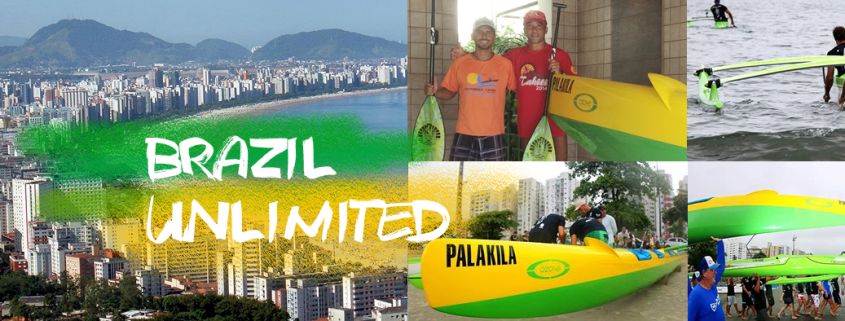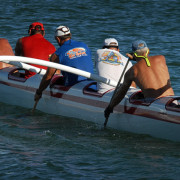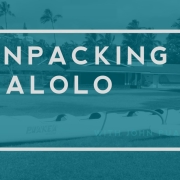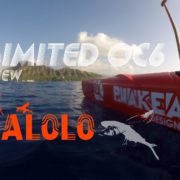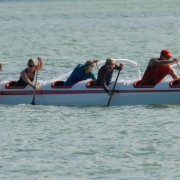Baptism Unlimited: The Blessing of Brazil’s First Unlimited Canoes
(Note: Paddlers in Brazil please contact Ozone Brazil clientes no Brasil entre em contato com Ozone Brasil)
Author: Estadão Conteúdo
Publisher: A Tribuna – atribuna.com.br
Santos, the largest port in South America and the largest coffee exporter in the world, is now stocked with some of the most modern canoes available. One canoe came from canoe designers in Tahiti and the other from designers in Hawaii. Now for the first time in Brazilian waters. These canoes are made of space craft technology, carbon fiber, kevlar and state of the art techniques. Ensuring a light-weight, fast, strong, high performance canoe .. especially in waves, but in every condition you can think of, these canoes thrive.
Introducing Palakila & Te Arii Vahine
The canoes are given names and are treated like family members, as is the Polynesian tradition. Today, on the Ponta da Praia in Santos, the coach of the Brazilian Canoe Confederation, Cauê Serra (name pronounced Kau-e), an aficionado in the sport and passionate for the Polynesian culture hosted the ceremony. “It is a way of showing respect and being thankful. The canoe is treated as a living entity”, he explained. With dozens of athletes present in the event, the two canoes were respectfully introduced, blessed and then they went to sea, as paddlers and spectators looked on, enjoying every aspect of the canoe performance, including testing it in the surf. “They are super modern boats, the first ones in Brazil like them. State of the art. They are very good in the waves. In Hawaii, the unlimited is a very recent evolution, 5 years old at most, and it is already making a big influence”.
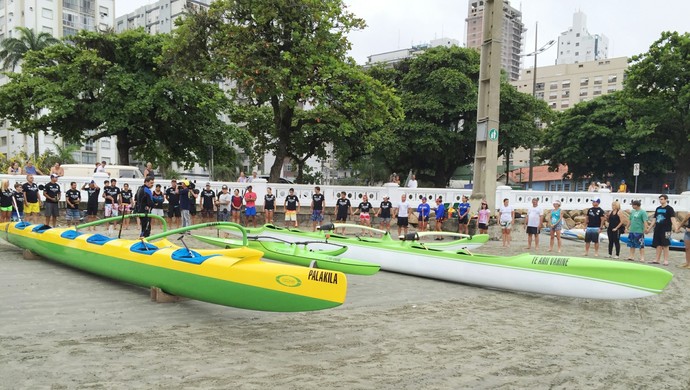
The baptism (blessing) of the canoes happened in the Ponta da Praia
About These Unlimited Canoes
The Hawaiian outrigger canoe (OC6) designed by Mike Giblin in Hawaii and built by Ozone, is in the Brazilian colors green and yellow, was baptized Palakila, which is a Hawaiian’ized translation of Brazil or Brazilian in local dialect. It weighs only 70 Kilograms (at least half of a conventional canoe) and is equipped with a drain to evacuate water, it comes equipped with foot braces for a more efficient foothold in the canoe as the paddler can brace and use the full body to engage the paddle and canoe. This canoe comes with so many features it is hard to explain, but it does an amazing job. The Va’a from Tahiti (V6) takes the name of Te Ari’i Vahine, Queen in Portuguese, name that is considered sacred in that country. It is made of wood, coated in carbon fiber and it possesses the characteristics of indigenous canoes.
Paddling in Brazil Takes A Leap
“It is unbelievable! We always want to see an improvement in the quality of our sport and now we have the best V6 of Tahiti and the best OC6 from Hawaii. It is a landmark to our history”, says in a cheerful manner, Celso Filleti, veterinarian medic responsible for the importation of these beautiful canoes. He has his own private collection of 30 canoes and is a Brazilian champion and South American master of OC1, individual Hawaiian canoe. He highlights more than the speed, the importance is the safety provided by the construction and added features, in example the deck, and that the canoes provide the ability to go further and faster. “We had the first OC6 in Brazil at the end of 2000 and now, in the beginning of 2015, another evolution. Those canoes can go through surf, long trips being very stable, resistant, and being practically unsinkable. And if any water goes in, it gets drained out. It is very cool because, we feel like we are planting a seed to harvest in the future”, he comments.
Canoe and Ocean Culture in Brazil
Fábio Paiva, responsible for the introduction of the sport in Brazil, in 2000, was moved by the presentation of the new canoes. He imported the first vessel from Hawaii, made the mold cask and even produced the boats that were shared throughout the entire coast, North to South and even in Brasilia. From the beginning until today, it was over 170 canoes. “It is an advance, a deep sense of pride and gratitude. It is very emotional to see that idea come about, from a very small beginning and now to this, and furthermore that ocean culture is effecting so many peoples lives, a lot of people are changing their lifestyle, their concepts and view points as we practice the culture and connect with the ocean”, he said.
Hawaiian canoe is one of the definitions for the traditionally used vessels in the regions of the Polynesian triangle, which resides in the Pacific Ocean, between Australia and the United States. Also called Waka, Wa’a, Va’a or Outrigger, they were integral to the Polynesian civilization, discovery and navigation of the islands, including, New Zealand, Tahiti, Fiji, Hawaii and all the way to Easter Island. Besides serving as a means of transportation between the island, they were used for fishing, they were precursors of surfing sport as well, because the rowers used to catch waves. All of them possess the three fundamental parts: The hull, the outrigger and the arms that tie one to the other (i’ako). The blessing is a tradition. In the past the canoes were made of a log from Koa wood, chosen by the priest. Then, they were blessed, to represent the birth of a new being, with spirit and soul, in accordance to the Polynesian culture. Hawaiians and Tahitians are today still the strongest paddlers in the world and they dominate the main racing events world wide.
~ *Editors Note: “Baptismo” is the word used for blessing in Brazil.
This article was first published in Portuguese at A Tribuna and was professionally translated by Amanda Rafael and edited by Naim Ferguson.

